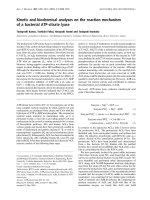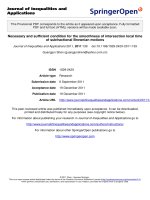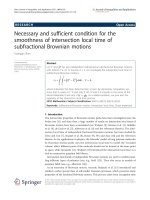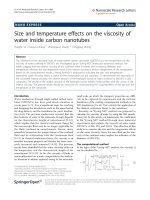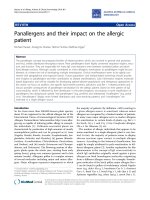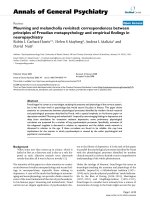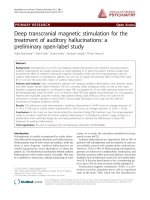Báo cáo y học: "Viral and cellular requirements for the budding of Feline Endogenous Retrovirus RD-114" ppt
Bạn đang xem bản rút gọn của tài liệu. Xem và tải ngay bản đầy đủ của tài liệu tại đây (422.1 KB, 16 trang )
This Provisional PDF corresponds to the article as it appeared upon acceptance. Fully formatted
PDF and full text (HTML) versions will be made available soon.
Viral and cellular requirements for the budding of Feline Endogenous Retrovirus
RD-114
Virology Journal 2011, 8:540 doi:10.1186/1743-422X-8-540
Aiko Fukuma ()
Masumi Abe ()
Shuzo Urata ()
Rokusuke Yoshikawa ()
Yuko Morikawa ()
Takayuki Miyazawa ()
Jiro Yasuda ()
ISSN 1743-422X
Article type Research
Submission date 19 August 2011
Acceptance date 14 December 2011
Publication date 14 December 2011
Article URL />This peer-reviewed article was published immediately upon acceptance. It can be downloaded,
printed and distributed freely for any purposes (see copyright notice below).
Articles in Virology Journal are listed in PubMed and archived at PubMed Central.
For information about publishing your research in Virology Journal or any BioMed Central journal, go
to
/>For information about other BioMed Central publications go to
/>Virology Journal
© 2011 Fukuma et al. ; licensee BioMed Central Ltd.
This is an open access article distributed under the terms of the Creative Commons Attribution License ( />which permits unrestricted use, distribution, and reproduction in any medium, provided the original work is properly cited.
Viral and cellular requirements for the budding
of Feline Endogenous Retrovirus RD-114
ArticleCategory :
Research Article
ArticleHistory :
Recieved: 19-Aug-2011; Accepted: 02-Dec-2011
ArticleCopyright
:
© 2011 Fukuma et al; licensee BioMed Central Ltd. This is an Open
Access article distributed under the terms of the Creative Commons
Attribution License ( which
permits unrestricted use, distribution, and reproduction in any medium,
provided the original work is properly cited.
Aiko Fukuma,
Aff1 Aff2 Aff3
Email:
Masumi Abe,
Aff2
Email:
Shuzo Urata,
Aff1 Aff2
Email:
Rokusuke Yoshikawa,
Aff4
Email:
Yuko Morikawa,
Aff3
Email:
Takayuki Miyazawa,
Aff4
Email:
Jiro Yasuda,
Aff1 Aff2
Corresponding Affiliation: Aff1
Phone: +81-95-8197848
Fax: +81-95-8197848
Email:
Aff1
Department of Emerging Infectious Diseases, Institute of Tropical
Medicine, Nagasaki University, Nagasaki 852-8523, Japan
Aff2
Fifth Biology Section for Microbiology, First Department of Forensic
Science, National Research Institute of Police Science, Kashiwa 277-
0882, Japan
Aff3
Kitasato Institute for
Life Sciences and Graduate School for Infection
Control, Kitasato University, Tokyo 108-8641, Japan
Aff4
Laboratory of Signal Transduction, Institute for Virus Research, Kyoto
University, Kyoto 606-8507, Japan
Abstract
Background
RD-114 virus is a feline endogenous retrovirus and produced as infectious viruses in some feline
cell lines. Recently, we reported the contamination of an infectious RD-114 virus in a proportion
of live attenuated vaccines for dogs and cats. It is very difficult to completely knock out the RD-
114 proviruses from cells, as endogenous retroviruses are usually integrated multiply into the
host genome. However, it may be possible to reduce the risk of contamination of RD-114 virus
by regulating the viral release from cells.
Results
In this study, to understand the molecular mechanism of RD-114 virus budding, we attempted to
identify the viral and cellular requirements for RD-114 virus budding. Analyses of RD-114 L-
domain mutants showed that the PPPY sequence in the pp15 region of Gag plays a critical role in
RD-114 virus release as viral L-domain. Furthermore, we investigated the cellular factors
required for RD-114 virus budding. We demonstrated that RD-114 virus release was inhibited by
overexpression of dominant negative mutants of Vps4A, Vps4B, and WWP2.
Conclusions
These results strongly suggest that RD-114 budding utilizes the cellular multivesicular body
sorting pathway similar to many other retroviruses.
Keywords
RD-114, Endogenous retrovirus, Budding, WWP2, MVB sorting, Vaccine
Background
The cat genome contains an infectious endogenous retrovirus (ERV), named RD-114 virus [1-3].
The RD-114 virus is a recombinant comprised of the gag-pol genes from a gammaretrovirus and
the env gene from a betaretrovirus [4]. The amounts of viral RNA reach approximately 100
copies per cells in feline cells [3]. Some feline cell lines, such as Crandell-Rees feline kidney
(CRFK) cells, constitutively express infectious RD-114 virus [5,6]. These cells have been used to
grow several live attenuated vaccines for cats and dogs. Recently, we reported the isolation of an
infectious RD-114 virus in a proportion of live attenuated vaccines for pets [7-9]. RD-114 is a
polytropic virus and has potential risks in that interspecies transmission may induce
unpredictable diseases, although the pathogenicity of RD-114 has not been demonstrated [5].
However, it is very difficult to completely exclude the proviral DNA of RD-114 from cells, as
ERVs are usually integrated into multiple loci of the host chromosomes. Therefore, it may be a
practical strategy to reduce the risk of contamination of RD-114 virus by regulating the release
of infectious RD-114 from cells.
It is unknown how RD-114 virus buds from the plasma membrane of infected cells. Gag proteins
of many retroviruses include short peptide motifs required for virus budding, i.e., L-domains. To
date, three types of L-domain motif have been identified: PT/SAP, PPxY, and YxxL [10]. The
PTAP motif interacts with Tsg101, an ubiquitin-conjugating E2 enzyme variant (UEV) and the
PPxY motif interacts with Nedd4-like E3 ubiquitin ligases [11-16]. The cellular factor that
interacts with the YxxL motif has been shown to be AIP1/Alix [17]. These host factors are the
cellular proteins involved in the multivesicular body (MVB) sorting pathway. The MVB
complex consists of a network of class E vacuolar protein sorting proteins, which form four
distinct heteromeric endosomal sorting complexes required for transport known as ESCRT
(endosomal sorting complexes required for transport)-0, -I, -II, and -III; these four complexes are
required for the formation and release of the vesicles of the MVB [11,17-20]. Their major
function in the cell is to transport cargo proteins, such as activated cell surface receptors, from
the early endosomal membrane to be released into the lysosome in small vesicles for
degradation. The proteins are targeted to the endosomal degradation pathway by modification
with mono- to tetraubiquitin chains. The components of ESCRT complexes participate in inward
invagination and budding of late endosomal membranes to form MVB. Therefore, the processes
of virus budding and MVB vesicle budding are considered fundamentally the same, although
they occur at different sites in the cell. The ESCRT machinery is processed by sequential
interaction of target protein with ESCRT-0, -I, -II, and –III [21]. Vps4 is an AAA ATPase and
performs a key function in this pathway by recognizing membrane-associated ESCRT-III
assemblies and catalyzing their disassembly, possibly in conjunction with membrane fission. It
has been reported that abrogations of the functions of these cellular factors using dominant-
negative mutants or siRNA inhibit viral release of various enveloped viruses possessing L-
domains.
In this study, to obtain the information useful for the inhibition of RD114 release from cells, we
analyzed the molecular mechanism of RD-114 virus budding.
Results
The PPPY sequence functions as a major L-domain in RD-114 replication
To examine the functions of two putative L-domain motifs in the pp15 region of RD-114 Gag,
PSAP and PPPY, we constructed expression plasmids for the RD-114 mutants, which substituted
PSAP, PPPY, or both sequences to all alanine, AAAA (Figure 1A). The expression plasmids for
wild-type (WT) or mutant RD-114 were transfected into 293 T cells. At 72 h posttransfection,
the amounts of the intracellular Gag precursor (Pr68) and the capsid protein (p28CA) in virus
particles were analyzed by Western blotting using anti-RD-114 Gag antibodies. As shown in
Figure 1B, similar levels of Gag precursor were synthesized in cells expressing either WT or
mutant genomes. The release of virus particles into the medium was greatly reduced by alanine
substitution of the PPPY motif, while the PSAP mutation had no apparent effect on virus
production. Moreover, the AAAA/AAAA mutant with the mutation introduced into both L-
domain motifs, PSAP and PPPY, showed the reduction of virus release as well as the
PSAP/AAAA mutant. The levels of virus production of mutants were also quantitatively
analyzed by real-time RT-PCR targeting the pol region (Figure 1C). The progeny virus
production of the PSAP/AAAA mutant or the AAAA/AAAA mutant was only 5.9% or 5.5% of
that of WT, respectively (p < 0.01), while the AAAA/PPPY mutant produced progeny virion at
the similar level to WT. Thus, the results of real-time RT-PCR were consistent with those of
Western blotting analysis. These data suggest that the PPPY motif, but not the PSAP motif, plays
a major role as an L-domain in RD-114 budding.
Figure 1 Identification of the L-domain, which is critical for RD-114 virus budding. (A)
Schematic representation of RD-114 Gag and the L-domain mutants. The positions of the two
putative L-domain motifs are indicated. (B and C) 293 T cells were transfected with the RD-114
infectious clone for wild-type (pTERD-114) or the L-domain mutant (0.5 µg). Cells and viruses
were collected at 72 h after transfection, and analyzed by Western blotting (B) and real-time RT-
PCR targeting the pol region (C). The virus production from cells expressing wild-type (WT)
RD-114 was set to 100%. The data are shown as averages and standard deviations of 3
independent experiments. Statistical analysis was performed by using the Student’s t-test (*: p <
0.01)
RD-114 production is inhibited by overexpression of the dominant-negative
mutant of WWP2
It has been reported that the PPxY sequence identified as a viral L-domain in various viruses
interacts with the WW domains of the cellular Nedd4-like E3 ubiquitin ligases[13,15]. This
interaction is essential for the function of the PPxY L-domain motif in virus budding, although
the precise role of Nedd4-like E3 ubiquitin ligases in virus budding has not been clarified. To
examine the involvement of Nedd4-like E3 ubiquitin ligases in the egress of RD-114, the RD-
114 infectious clone, pTERD-114, was cotransfected with plasmids directing expression of the
dominant-negative mutants of Nedd4, Nedd4L, BUL1, WWP2, and Smurf2, Nedd4-WW,
Nedd4L-WW, BUL1-WW, WWP2-WW, and Smurf2-WW, which express only WW domains,
into 293 T cells and monitored for impact on RD-114 virus production by Western blotting and
real-time RT-PCR as in Figure 1. As shown in Figure 2A, virus production was significantly
reduced to 2% of control by overexpression of WWP2-WW (p < 0.01). The effects of these WW
domains of the cellular Nedd4-like E3 ubiquitin ligases were also investigated in CRFK cells,
which is a feline cell line constitutively expressing infectious endogenous RD-114. The analysis
was performed by real-time RT-PCR as it was difficult to detect the low levels of RD-114 virus
production from CRFK cells by Western blotting (Figure 2B). It was shown that WWP2-WW
also significantly inhibited the production of endogenous RD-114 expression to 1% of control in
CRFK cells. These results suggest that WWP2 or another HECT E3 ubiquitin ligase closely
related to WWP2 is involved in RD-114 budding.
Figure 2 Effects of dominant-negative mutants of Nedd4-like E3 ubiquitin ligases on RD-114
production. (A) 293 T cells were cotransfected with pTERD-114 (100 ng) and either the
expression plasmid for the dominant-negative mutants of Nedd4-like E3 ubiquitin ligases, which
express only WW domains containing N-terminal FLAG-tag, or the empty vector pCDNFL
(Control) (1 µg). Cells and viruses were collected at 72 h after transfection, and analyzed by
Western blotting (upper) and real-time RT-PCR (lower). The virus production in Control was set
to 100%. The data are shown as averages and standard deviations of 3 independent experiments.
(B) CRFK cells were transfected with the expression plasmid for the dominant-negative mutant
of Nedd4-like E3 ubiquitin ligases (1 µg) and analyzed as in (A). Statistical analysis was
performed by using the Student’s t-test (*: p < 0.01)
RD-114 budding depends on ESCRT machinery
Identification of functional L-domain in RD-114 Gag and the involvement of Nedd4-like E3
ubiquitin ligase in RD-114 budding strongly suggest that RD-114 utilizes the ESCRT machinery
in its budding similar to many other enveloped viruses [10]. It has been reported that
overexpression of the ATPase-deficient mutant of Vps4A or Vps4B, Vps4AE228Q or
Vps4BE235Q, inhibited the release of a unique subset of ESCRT-utilizing retroviruses
depending on L-domain differences in a dominant-negative manner [11]. To determine whether
RD-114 virus budding utilizes the ESCRT machinery, 293 T cells were cotransfected with the
plasmid for Vps4AE228Q or Vps4BE235Q along with pTERD-114. At 72 h posttransfection,
viral protein synthesis and virion release were analyzed by Western blotting and real-time RT-
PCR as shown in Figure 1. We observed that virus release was significantly reduced to 4.4% or
15%, respectively, by the overexpression of Vps4AEQ or Vps4BEQ (p < 0.01) (Figure 3A). We
also analyzed the effects of Vps4AE228Q or Vps4BE235Q overexpression in CRFK cells
(Figure 3B). The virus release of RD-114 endogenously expressed in CRFK cells was also
inhibited by the overexpression of Vps4AE228Q or Vps4BE235Q, indicating that RD-114
utilizes the cellular ESCRT machinery in the budding of progeny viruses.
Figure 3 Inhibition of RD-114 production by overexpression of the dominant-negative mutants
of Vps4A/B. (A) 293 T cells were cotransfected with pTERD-114 (100 ng) and either the
expression plasmids for Vps4A/B dominant-negative mutant containing N-terminal FLAG-tag,
or the empty vector pCDNFL (Control) (100 ng), and then analyzed by Western blotting (upper)
and real-time RT-PCR (lower) as in Figure 1. The virus production in Control was set to 100%.
The data are shown as averages and standard deviations of 3 independent experiments. Statistical
analysis was performed by using the Student’s t-test (*: p < 0.01). (B) CRFK cells were
transfected with the expression plasmids Vps4A/B dominant-negative mutant (1 µg). Cells and
viruses were collected at 72 h after transfection, and analyzed by Western blotting (upper) and
real-time RT-PCR (lower) as in (A).
Discussion
In this study, we demonstrated that the PPPY sequence in the pp15 region of RD-114 Gag plays
a critical role in virus production as a major L-domain and that WWP2 or WWP2-like E3
ubiquitin ligases possessing the WW domain closely related to WWP2 and Vps4A/B are
involved in RD-114 budding. These data suggest that RD-114 Gag recruit the cellular ESCRT
machinery through the interaction of the PPPY L-domain with the WW domain(s) of WWP2 and
progeny virions are released from cells by utilizing the MVB sorting pathway similar to many
other retroviruses. Therefore, strategies targeting these cellular proteins might be effective to
suppress endogenous RD-114 production from feline cells. In fact, overexpression of dominant-
negative mutants of WWP2 and Vps4A/B could markedly inhibit the production of endogenous
RD-114 viruses from CRFK cells as well as exogenous RD-114 viruses from 293 T cells
(Figures 2 and 3).
WWP2 is known to negatively regulate transcriptional activity of Oct-4, which is a transcription
factor critical in mammalian embryonic development, by promoting ubiquitination of Oct-4 [22].
Oct-4 is present in cultured undifferentiated embryonic cell lines, including embryonic stem (ES)
cells, embryonal carcinoma cells, and embryonic germ cells, while it is absent from all of the
differentiated somatic cell types in vitro and in vivo [23]. A recent study also showed that WWP2
inhibits activation-induced T-cell death by catalyzing ubiquitination of EGR2, which is a zinc
finger transcription factor that regulates Fas ligand (FasL) expression [24]. Therefore, abrogation
of WWP2 function by constitutive expression of dominant-negative mutant may be possible in
most of the differentiated somatic cell lines that have been used for production of vaccine or
biological substances.
Furthermore, we recently reported that matrix proteins (VP40) of Ebola and Marburg viruses
recognize a different WW domain within Nedd4.1, although both VP40 proteins interact with
Nedd4.1 via their PPxY L-domain [25]. WWP2 contains four WW domains [22]. Identification
of the WW domain that specifically binds to RD-114 Gag may enable the development of
strategies that have minimal effect on physiological function of WWP2 and efficiently reduce
endogenous RD-114 production.
Strategies targeting Vps4 might also be available to reduce endogenous RD-114 production.
Recently, a stable cell line with inducible expression of a dominant-negative form of Vps4 has
been established [26]. This method would be applicable to the various cellular factors the
dominant-negative forms of which inhibit RD-114 production.
Taken together, our data would be useful for development of the strategies to control virus
production in cells constitutively producing infectious endogenous viruses.
Conclusions
In this study, we revealed that the PPPY sequence in the pp15 region of Gag plays a critical role
in the virus budding of RD-114 as viral L-domain. Furthermore, we demonstrated that RD-114
virus production was significantly inhibited by overexpression of dominant-negative mutants of
Vps4A, Vps4B, and WWP2. These results strongly suggest that RD-114 budding utilizes the
MVB sorting pathway similar to many other retroviruses.
Methods
Cells
Human embryonic kidney (HEK) 293 T cells (ATCC CRL-11268), and Crandell-Rees feline
kidney (CRFK) cells (ATCC CCL-94) were maintained at 37°C in a 5% CO
2
incubator in
Dulbecco’s modified Eagle’s medium (Sigma, St. Louis, MO) supplemented with 10% fetal
bovine serum and penicillin/streptomycin.
Plasmids
A plasmid containing an intact infectious clone of RD-114, pTERD-114, was constructed from
TE/RD114 cell [27,28]. To generate the expression plasmids for the RD-114 L-domain mutants,
AAAA/PPPY, PSAP/AAAA, and AAAA/AAAA (Figure 1A), alanine substitutions were
introduced into pTERD-114 by site-directed mutagenesis using a KOD-Plus-Mutagenesis Kit
(Toyobo, Osaka, Japan). The expression plasmids for each dominant-negative mutant of Nedd4,
BUL1, Vps4A, and Vps4B: pNedd4-WW (NP_006145, amino acid region 192–506), pBUL1-
WW (NP_055867, amino acid region 830–1051), pVps4AE228Q, and pVps4BE235Q,
respectively, were constructed previously [15,16,29]. The expression plasmids for each
dominant-negative mutant of Nedd4L, WWP2, and Smurf2: pNedd4L-WW (NP_001138442,
amino acid region 68–456), pWWP2-WW (NP_008945, amino acid region 293–485), and
pSmurf2-WW (NP_073576, amino acid region 151–338), were constructed in this study. Each
WW construct of Nedd4L, WWP2, and Smurf2 was amplified by standard PCR using primer
containing KpnI sites from the human spleen Marathon-Ready cDNA library (Clontech,
Mountain View, CA). These products were subcloned into pCDNFL, which was constructed
from pcDNA3.1 (Invitrogen, Carlsbad, CA) to express a protein containing a FLAG-tag at the N
terminus.
Production of anti-RD-114 Gag antibody
RD-114 Gag (amino acid residues 225–550) was expressed in Escherichia coli BL21 as a GST
fusion protein (from pGEX6P-2; GE Healthcare, Piscataway, NJ), and purified from the bacterial
extracts according to the manufacturer’s instructions. As the GST fusion proteins attached to the
glutathione-Sepharose 4B beads were digested with PreScission protease (GE Healthcare), the
purified Gag protein did not contain GST. The purified Gag protein was used to immunize
rabbits.
Western blot analyses
For L-domain mutant analysis, 293 T cells (2 × 10
5
) were transfected with the expression
plasmid for RD-114 wild-type or L-domain mutant, AAAA/PPPY, PSAP/AAAA, or
AAAA/AAAA, using Trans-IT LT-1 (Mirus Bio Corp., Madison, WI). For analyses of the
cellular factors, 293 T or CRFK cells (2 × 10
5
) were cotransfected with pTERD-114 (100 ng) and
pNedd4-WW, pNedd4L-WW, pBUL1-WW, pWWP2-WW, pSmurf2-WW, pVps4AE228Q, or
pVps4BE235Q (0.1 or 1 µg) using Trans-IT LT-1. At 72 h after transfection, the supernatants
were separated from cell debris by centrifugation (10,000 × g; 15 min) and then virions were
pelleted through a 16.5% sucrose cushion by ultracentrifugation (348,000 × g; 40 min at 4°C)
[27]. Pelleted virions were resuspended in PBS(−). Cells were lysed with lysis A buffer [30].
Cell lysates and virions were analyzed by Western blotting using anti-RD-114 Gag antibody,
anti-FLAG M2 antibody (Sigma), and anti-actin antibody (Sigma) as described previously
[27,29,31,32].
Real-time RT-PCR
To quantify the release of progeny virions from cells, virions were prepared as described in
Western blot analyses. Viral RNAs were extracted from pelleted virions using a QIAamp Viral
RNA Mini Kit (QIAGEN, Valencia, CA). After DNaseI treatment, real-time RT-PCR was
performed using a One Step SYBR RT-PCR Kit (Takara, Shiga, Japan). The primers targeting
the RD-114 pol region, 5′-GAGACCCTTACTAAATTGAC-3′ (forward) and 5′-
AGTTTCTGGTCCAGGGGTTT-3′ (reverse), were used for real-time RT-PCR [33]. The
amplification was carried out in a 25-µl reaction volume and contained 12.5 µl of 2× One Step
SYBR RT-PCR Buffer III, 2.5 U of TaKaRa Ex Taq HS, 0.5 µl of PrimeScript RT enzyme Mix
II, 5 pmol of forward and reverse primers, and 2 µl of RNA sample. The thermal profile was at
42°C for 5 min and 95°C for 10 s, followed by 45 cycles of 95°C for 5 s, 60°C for 20 s, and 72°C
for 15 s. Thermal cycling and quantification were performed using a Smart Cycler II System
(Cepheid, Sunnyvale, CA).
Abbreviations
ERV, endogenous retrovirus; CRFK, Crandell-Rees feline kidney; UEV, ubiquitin-conjugating
E2 enzyme variant; ESCRT, endosomal sorting complexes required for transport; MVB,
multivesicular body; WT, wild-type; ES cells, embryonic stem cells; FasL, Fas ligand; HEK 293
T cells, Human embryonic kidney 293 T cells.
Competing interests
The authors declare that they have no competing interests.
Authors’ contributions
AF designed the study, carried out experiments, participated in analysis of the results, and wrote
the manuscript. MA and SU participated in analysis of the results. YM helped in drafting the
manuscript and performed critical revisions. TM designed the study and participated in analysis
of the results. JY designed the study, participated in analysis of the results, and participated in
manuscript preparation. All authors have read and approved the final manuscript.
Acknowledgments
This work was supported by the grant from the Bio-oriented Technology Research Advancement
Institution.
References
1. Fischinger PJ, Peebles PT, Nomura S, Haapala DK: Isolation of RD-114-like oncornavirus from a
cat cell line. J Virol 1973, 11:978–985.
2. McAllister RM, Nicolson M, Gardner MB, Rongey RW, Rasheed S, Sarma PS, Huebner RJ, Hatanaka
M, Oroszlan S, Gilden RV, et al: C-type virus released from cultured human rhabdomyosarcoma
cells. Nat New Biol 1972, 235:3–6.
3. Okabe H, Gilden RV, Hatanaka M: RD 114 virus-specific sequences in feline cellular RNA:
detection and characterization. J Virol 1973, 12:984–994.
4. van der Kuyl AC, Dekker JT, Goudsmit J: Discovery of a new endogenous type C retrovirus (FcEV)
in cats: evidence for RD-114 being an FcEV(Gag-Pol)/baboon endogenous virus BaEV(Env)
recombinant. J Virol 1999, 73:7994–8002.
5. Okada M, Yoshikawa R, Shojima T, Baba K, Miyazawa T: Susceptibility and production of a feline
endogenous retrovirus (RD-114 virus) in various feline cell lines. Virus Res 2011, 155:268–273.
6. Baumann JG, Gunzburg WH, Salmons B: CrFK feline kidney cells produce an RD114-like
endogenous virus that can package murine leukemia virus-based vectors. J Virol 1998, 72:7685–
7687.
7. Miyazawa T: Endogenous retroviruses as potential hazards for vaccines. Biologicals: J Int Assoc
Biol Standardization 2010, 38:371–376.
8. Miyazawa T, Yoshikawa R, Golder M, Okada M, Stewart H, Palmarini M: Isolation of an infectious
endogenous retrovirus in a proportion of live attenuated vaccines for pets. J Virol 2010, 84:3690–
3694.
9. Yoshikawa R, Sato E, Miyazawa T: Contamination of infectious RD-114 virus in vaccines
produced using non-feline cell lines. Biologicals 2011, 39:33–37.
10. Bieniasz PD: Late budding domains and host proteins in enveloped virus release. Virology 2006,
344:55–63.
11. Garrus JE, von Schwedler UK, Pornillos OW, Morham SG, Zavitz KH, Wang HE, Wettstein DA,
Stray KM, Cote M, Rich RL, et al: Tsg101 and the vacuolar protein sorting pathway are essential for
HIV-1 budding. Cell 2001, 107:55–65.
12. Kikonyogo A, Bouamr F, Vana ML, Xiang Y, Aiyar A, Carter C, Leis J: Proteins related to the
Nedd4 family of ubiquitin protein ligases interact with the L domain of Rous sarcoma virus and are
required for gag budding from cells. Proc Natl Acad Sci U S A 2001, 98:11199–11204.
13. Martin-Serrano J, Eastman SW, Chung W, Bieniasz PD: HECT ubiquitin ligases link viral and
cellular PPXY motifs to the vacuolar protein-sorting pathway. J Cell Biol 2005, 168:89–101.
14. VerPlank L, Bouamr F, LaGrassa TJ, Agresta B, Kikonyogo A, Leis J, Carter CA: Tsg101, a
homologue of ubiquitin-conjugating (E2) enzymes, binds the L domain in HIV type 1 Pr55(Gag).
Proc Natl Acad Sci U S A 2001, 98:7724–7729.
15. Yasuda J, Hunter E, Nakao M, Shida H: Functional involvement of a novel Nedd4-like ubiquitin
ligase on retrovirus budding. EMBO Rep 2002, 3:636–640.
16. Yasuda J, Nakao M, Kawaoka Y, Shida H: Nedd4 regulates egress of Ebola virus-like particles
from host cells. J Virol 2003, 77:9987–9992.
17. Strack B, Calistri A, Craig S, Popova E, Gottlinger HG: AIP1/ALIX is a binding partner for HIV-1
p6 and EIAV p9 functioning in virus budding. Cell 2003, 114:689–699.
18. Eastman SW, Martin-Serrano J, Chung W, Zang T, Bieniasz PD: Identification of human VPS37C,
a component of endosomal sorting complex required for transport-I important for viral budding. J
Biol Chem 2005, 280:628–636.
19. Martin-Serrano J, Yarovoy A, Perez-Caballero D, Bieniasz PD: Divergent retroviral late-budding
domains recruit vacuolar protein sorting factors by using alternative adaptor proteins. Proc Natl
Acad Sci U S A 2003, 100:12414–12419.
20. Stuchell MD, Garrus JE, Muller B, Stray KM, Ghaffarian S, McKinnon R, Krausslich HG, Morham
SG, Sundquist WI: The human endosomal sorting complex required for transport (ESCRT-I) and its
role in HIV-1 budding. J Biol Chem 2004, 279:36059–36071.
21. Hurley JH, Emr SD: The ESCRT complexes: structure and mechanism of a membrane-
trafficking network. Annu Rev Biophys Biomol Struct 2006, 35:277–298.
22. Xu HM, Liao B, Zhang QJ, Wang BB, Li H, Zhong XM, Sheng HZ, Zhao YX, Zhao YM, Jin Y:
Wwp2, an E3 ubiquitin ligase that targets transcription factor Oct-4 for ubiquitination. J Biol Chem
2004, 279:23495–23503.
23. Yeom YI, Fuhrmann G, Ovitt CE, Brehm A, Ohbo K, Gross M, Hubner K, Scholer HR: Germline
regulatory element of Oct-4 specific for the totipotent cycle of embryonal cells. Development 1996,
122:881–894.
24. Chen A, Gao B, Zhang J, McEwen T, Ye SQ, Zhang D, Fang D: The HECT-type E3 ubiquitin
ligase AIP2 inhibits activation-induced T-cell death by catalyzing EGR2 ubiquitination. Mol Cell
Biol 2009, 29:5348–5356.
25. Urata S, Yasuda J: Regulation of Marburg virus (MARV) budding by Nedd4.1: a different WW
domain of Nedd4.1 is critical for binding to MARV and Ebola virus VP40. J Gen Virol 2010,
91:228–234.
26. Kolesnikova L, Strecker T, Morita E, Zielecki F, Mittler E, Crump C, Becker S: Vacuolar protein
sorting pathway contributes to the release of Marburg virus. J Virol 2009, 83:2327–2337.
27. Fukuma A, Abe M, Morikawa Y, Miyazawa T, Yasuda J: Cloning and characterization of the
antiviral activity of feline Tetherin/BST-2. PloS one 2011, 6:e18247.
28. Yoshikawa R, Sato E, Igarashi T, Miyazawa T: Characterization of RD-114 virus isolated from a
commercial canine vaccine manufactured using CRFK cells. J Clin Microbiol 2010, 48:3366–3369.
29. Urata S, Noda T, Kawaoka Y, Yokosawa H, Yasuda J: Cellular factors required for Lassa virus
budding. J Virol 2006, 80:4191–4195.
30. Yasuda J, Hunter E: A proline-rich motif (PPPY) in the Gag polyprotein of Mason-Pfizer monkey
virus plays a maturation-independent role in virion release. J Virol 1998, 72:4095–4103.
31. Sakuma T, Noda T, Urata S, Kawaoka Y, Yasuda J: Inhibition of Lassa and Marburg virus
production by tetherin. J Virol 2009, 83:2382–2385.
32. Urata S, Noda T, Kawaoka Y, Morikawa S, Yokosawa H, Yasuda J: Interaction of Tsg101 with
Marburg virus VP40 depends on the PPPY motif, but not the PT/SAP motif as in the case of Ebola
virus, and Tsg101 plays a critical role in the budding of Marburg virus-like particles induced by
VP40, NP, and GP. J Virol 2007, 81:4895–4899.
33. Sakaguchi S, Baba K, Ishikawa M, Yoshikawa R, Shojima T, Miyazawa T: Focus assay on RD114
virus in QN10S cells. J Vet Med Sci 2008, 70:1383–1386.
Figure 1
Figure 2
Figure 3
